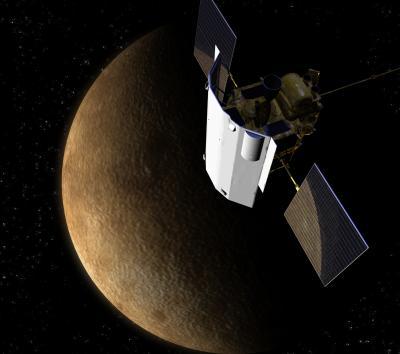This time, too, the spacecraft will photograph segments that have not been photographed before from the surface of the planet, and will perform measurements in the ultraviolet to determine the mineral composition of the surface

The American spacecraft Mercury Messenger, built and managed by the University of Colorado at Boulder, will make its second approach flight to the planet Hema today, October 6.
The spacecraft, moving at a speed of 6.5 kilometers per second, will approach a distance of about 200 kilometers from the surface of the planet Hema and photograph another section of the surface that has not been photographed by any spacecraft before. As MESSENGER moves away from the planet, it will see a region seen in high resolution only once before - when the Mariner 10 spacecraft approached Mercury in 1974 and 1975, says William McClinnock, one of the mission's senior investigators, from the Laboratory for Atmospheric and Space Physics at the University of Colorado at Boulder.
MESSENGER, launched in 2004, will make its final approach to the planet closest to the Sun in October 2009 and will eventually enter a permanent orbit around it in 2011. The maneuvers, which will cause the spacecraft to travel about 8 billion kilometers, required six years and 15 loops around the Sun to bring it closer to the orbit of the planet Mercury. According to McClintock, who developed the Mercury Atmosphere and Surface Composition Spectrometer (MASCS), he managed to miniaturize the instrument to less than 4 kilograms.
The spacecraft is equipped with a sun shield and a heat-resistant ceramic coating to protect it from the sun, and more than half of its weight - which totals about 1.2 of the spacecraft at the time of launch - contained fuel and helium. "We are two-thirds of the way there, but we still have a lot of work to do," McClintock said. "We are constantly refining our plans, including developing backup plans in case of an unexpected emergency.
The spacecraft carries seven instruments - a camera, a magnetometer, an altimeter and four spectrometers. Data from MASCS earlier this year during the first flyby on January 14 provided researchers with evidence that 10% of the sodium atoms are ejected from the hot surface of Mercury during the day, producing a 40 km long sodium trail that follows the planet.
MESSENGER will collect data for about 90 deciles during today's approach, including the first observation in the ultraviolet region, McClinnock says. The scanner that will take the picture will look at the light reflected from the surface of Mercury to better determine the mineral composition of the planet. This follows surprising observations in part of the infrared range in January, now we have expanded the range of photography to discover better details. Observations will also be made on the relationship between the solar wind and what is happening on the surface of the planet Hema.
The approach is expected to begin at 12:40 p.m. Israel time on October 6.

One response
Apparently the photographs are of a purple owner.
Sub-violet is in the visible range!